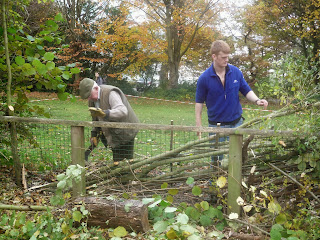Oak apple or oak gall is the common name for a large, round, vaguely apple-like gall commonly found on many species of oak. Oak apples range in size from 2–5 cm in diameter and are caused by chemicals injected by the larva of certain kinds of gall wasp in the family Cynipidae.[1] The adult female wasp lays single eggs in developing leaf buds. The wasp larvae feed on the gall tissue resulting from their secretions. Considerable confusion exists in the general 'literature' between the oak apple and the oak marble gall. The oak marble is frequently called the oak apple due to the superficial resemblance and the preponderance of the oak marble gall in the wild. Other galls found on oak trees include the Oak artichoke galland the Acorn cup gall, but each of these has its own distinctive form .(Text Courtesy of Wikipedia)
2 December 2013
17 November 2013
8 October 2013
Apple Day at Eastham Country Park
Wirral Wildlife, the Wirral Tree Wardens and the Mersey Morris Men celebrate the English Apple at Eastham Country Park. This year there was a bumper crop of apples (36 different varieties) arrayed for people to sample. And to top it all the Mersey Morris Men were on hand to add a real festival feel to the day.
 |
| Sunday 6th October 2013 Apple Day at Eastham Country Park |
12 September 2013
10 August 2013
The Mayor of Wirral Raises The Green Flag at Eastham Country Park
The Mayor of Wirral Cllr Dave Mitchell and the Mayoress join James locke Senior Ranger on the pier at Eastham Country Park to celebrate the park winning the prestigious Green Flag Award
Councillor Mitchell who was leading a party of visiting Mayors from across the region on a show case tour of the borough is a regular visitor to the park and gave the party a very informative talk about the park and the history of the area.
16 June 2013
On The Trail of Owls
 |
| Terry introduces some of the group to his Barn Owl |
 |
 |
| Sasha aged 4 comes face to face with a European Eagle Owl |
 |
 |
| The Eagle Owl shows of it's 5 ft wing span |
5 May 2013
Spring / Summer in the Woods
Late spring early summer at Eastham Woods is a very special time. It is the time when many of the wild flowers that thrive in the ancient woodland come into flower. For about eight weeks, between late March and mid May, Just before the trees burst into leaf and shade out the woodland floor.
This is the time when we see some of the most spectacular displays of wild flowers: flowers such as Daffodils (though to find wild native daffodils these days is becoming quite rare) lesser Celandine and Snow Drops which can be seen quite early on in Spring, but it is the Blue Bells and the Wood Anemone that create the wow factor as we
stroll through the woodland.
Eastham Woods is one of the last remaining ancient woodlands left on the Wirral, but there was a time when most of the peninsular would have been developed as a woodland for Aristocrats. Men such as Hugh Lupus who was a Councillor to William The Conqueror, who made him
1st Earl of Chester. The woodlands would have been ideal places to hunt Deer or Wild Boar. They are just as important to us today as they were to the previous generations. In fact they are probably more important today in an age of heavy industry and mass house building as they act a a lung, filtering the very air that we breath.
1st Earl of Chester. The woodlands would have been ideal places to hunt Deer or Wild Boar. They are just as important to us today as they were to the previous generations. In fact they are probably more important today in an age of heavy industry and mass house building as they act a a lung, filtering the very air that we breath.
Labels:
Wild Flowers
23 April 2013
8 April 2013
20 January 2013
Subscribe to:
Comments (Atom)





















.JPG)

.JPG)

